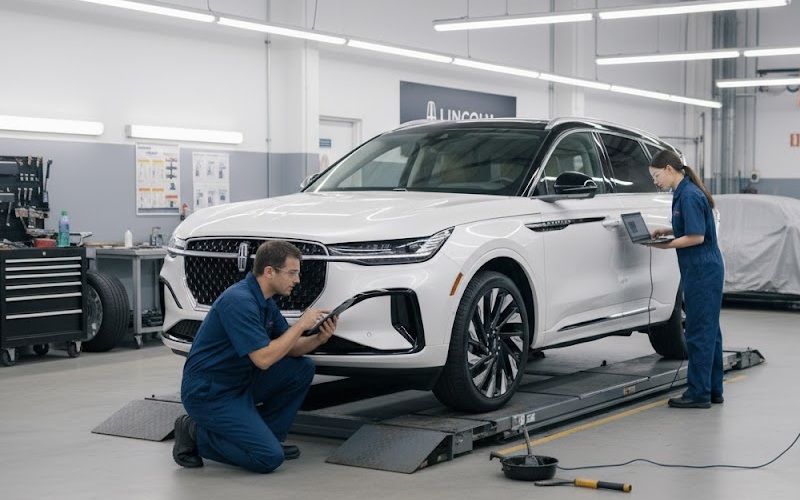The Lincoln Motor Company has established itself as a premier luxury automotive brand, delivering sophisticated vehicles that combine advanced technology with refined comfort. This level of engineering excellence requires an equally advanced approach to Lincoln service and maintenance, particularly when diagnosing complex issues. The Lincoln comprehensive diagnostic protocol ensures that each vehicle receives meticulous attention from trained technicians using state-of-the-art equipment. Understanding this systematic approach not only provides peace of mind for Lincoln owners but also highlights the brand’s commitment to maintaining the highest standards of performance and reliability.

The Lincoln Service Diagnostic Philosophy
At the foundation of the Lincoln approach to vehicle diagnosis is a philosophy that emphasizes thorough investigation before intervention. This methodical process ensures that technicians identify the root cause of issues rather than simply addressing symptoms.
Customer-Centric Approach
The diagnostic journey begins with active listening. Lincoln technicians engage with owners to gather detailed information about their concerns:
- When the issue occurs (cold start, highway speeds, etc.)
- How frequently the problem manifests
- Any sounds, smells, or sensations associated with the concern
- Changes in vehicle performance or behaviour
- Recent Lincoln service or modifications to the vehicle
This information creates a foundation for the diagnostic process, allowing technicians to focus their investigation efficiently.
Systematic Over Speculative
Lincoln protocol emphasizes systematic testing over speculative parts replacement. This approach:
- Minimizes unnecessary repairs
- Reduces diagnostic time
- Ensures accurate identification of underlying issues
- Provides clear documentation of the problem
- Leads to more effective long-term solutions
Initial Assessment and Verification
The first technical phase of the diagnostic protocol involves thorough assessment and verification of the reported concern.
Vehicle History Review
Technicians begin by examining the complete service history:
- Previous repairs and maintenance
- Software update status
- Recall and Lincoln service bulletin compliance
- Pattern failures associated with the specific model
- Maintenance adherence to the recommended Lincoln service schedule
Visual Inspection
A comprehensive visual inspection follows, with technicians examining:
- Fluid levels and condition
- Belt and hose integrity
- Electrical connections
- Obvious signs of leakage or damage
- Component condition in the affected system
Concern Verification
The technician will attempt to reproduce the reported issue through:
- Test drive under similar conditions
- System operation tests
- Simulation of environmental factors when possible
- Sequential testing of related components
- Verification of normal operation parameters
Advanced Electronic Diagnosis
Lincoln vehicles feature sophisticated electronic systems that require specialized diagnostic approaches.
Diagnostic Interface Connection
Using Lincoln-specific diagnostic equipment, technicians connect to the vehicle’s onboard systems:
- SYNC and infotainment diagnosis through specialized interfaces
- Powertrain control module access
- Body control module interrogation
- Advanced driver assistance systems evaluation
- Network communication testing between modules
Diagnostic Trouble Code Analysis
The technician retrieves and analyzes diagnostic trouble codes (DTCs):
- Active codes currently triggering warnings
- Pending codes that have not yet illuminated warning lights
- History codes that have occurred previously
- Freeze frame data showing conditions when the fault occurred
- Module self-test results
Live Data Analysis
Beyond static code retrieval, technicians analyze live data parameters:
- Sensor readings during operation
- Actuator response testing
- System operation under varying conditions
- Performance comparisons to specification
- Inter-system communication evaluation
Specialized System Diagnosis
Different systems require specialized diagnostic approaches tailored to their unique characteristics.
Powertrain Diagnosis
For advanced powertrains, including the 3.0L twin-turbocharged V6 and hybrid systems, technicians employ:
- Cylinder power balance testing
- Compression and leak-down analysis
- Fuel system pressure and volume measurement
- Turbocharger boost and wastegate function tests
- Transmission pressure and shift quality evaluation
Electronic Feature Diagnosis
Lincoln luxury features require specialized diagnosis:
- Perfect Position seat movement and memory function verification
- Adaptive LED headlight system evaluation
- Power liftgate and door operation analysis
- Climate control system performance testing
- Active noise control system verification
Advanced Driver Assistance Systems
Modern Lincoln models feature sophisticated driver assistance technology requiring specialized diagnosis:
- Radar and camera alignment verification
- Sensor calibration validation
- System response testing under controlled conditions
- Integration testing between multiple ADAS functions
- Software version verification and update requirements
Diagnostic Equipment and Technology
Diagnosis protocol relies on advanced equipment designed specifically for the brand’s unique systems.
Lincoln-Specific Diagnostic Tools
Technicians utilize specialized equipment, including:
- Integrated Diagnostic Software (IDS) with Lincoln-specific programming
- Module Programming Utility for software updates
- Vehicle Communication Module (VCM) interfaces
- SYNC diagnostic utilities
- Vehicle Measurement System for precision mechanical measurements
Advanced Testing Equipment
Beyond electronic diagnosis, Lincoln service technicians employ:
- Infrared thermal imaging to identify heat-related issues
- Ultrasonic leak detection for air and fluid systems
- Pressure transducers for hydraulic and pneumatic testing
- Digital oscilloscopes for complex electrical analysis
- Fuel system analyzers for precise fuel delivery measurement
The Four-Phase Diagnostic Protocol
Comprehensive diagnosis follows a structured four-phase approach that ensures thorough investigation and accurate results.
Phase 1: Identification
In this initial phase, technicians:
- Document the customer concern in detail
- Review technical Lincoln service bulletins and recalls
- Verify the issue through direct observation
- Consult the Lincoln Technical Assistance Centre when necessary
- Develop an initial diagnostic strategy
Phase 2: Analysis
The second phase involves:
- Systematic testing of affected systems
- Data collection and interpretation
- Comparison to known-good values
- Isolation of the fault area
- Elimination of functioning components from consideration
Phase 3: Root Cause Determination
In this critical phase, technicians:
- Identify the specific component or system causing the issue
- Determine why the failure occurred
- Document the diagnostic path
- Verify findings through focused testing
- Consider related systems that may be affected
Phase 4: Solution Development
The final phase includes:
- Creating a comprehensive repair plan
- Identifying all required parts and procedures
- Estimating the required time and resources
- Developing a verification strategy
- Planning post-repair testing to ensure complete resolution
Diagnostic Challenges in Modern Lincoln Vehicles
Today’s Lincoln models present unique diagnostic challenges due to their advanced technology and integrated systems.
Network Complexity
Modern Lincoln vehicles contain multiple interconnected networks:
- High-speed CAN networks for critical powertrain functions
- Medium-speed networks for body and comfort systems
- MOST networks for infotainment functions
- LIN networks for localized control modules
This complexity requires sophisticated diagnosis to identify communication issues between systems.
Software-Dependent Features
Many Lincoln functions are software-controlled:
- Drive modes that alter vehicle character
- Adaptive suspension systems
- Driver assistance features
- Personalization settings
- Over-the-air update capabilities
Diagnosing these features often requires software analysis rather than traditional mechanical or electrical testing.
Multiple Control Strategies
Lincoln vehicles employ adaptive control strategies that:
- Learn driver habits and preferences
- Adjust to environmental conditions
- Modify operation based on wear and aging
- Compensate for minor component variations
- Operate differently based on selected drive modes
These adaptive systems can complicate diagnosis as “normal” operation varies based on conditions and history.
The Future of Lincoln Service Diagnostics
As Lincoln vehicles continue to evolve, so too does the diagnostic approach used to maintain them.
Artificial Intelligence Integration
Lincoln is incorporating AI-assisted diagnostics that:
- Analyze patterns across thousands of similar vehicles
- Predict potential failures before they occur
- Suggest optimal diagnostic paths based on symptoms
- Learn from successful repairs to improve future diagnosis
- Reduce diagnostic time through intelligent problem-solving
Remote Diagnostic Capabilities
Advanced connectivity enables:
- Pre-visit diagnosis through vehicle telematics
- Real-time data monitoring between Lincoln service intervals
- Remote software updates to address known issues
- Proactive Lincoln service scheduling based on vehicle condition
- Digital service records that follow the vehicle throughout its life
Augmented Reality Tools
Emerging technology allows technicians to:
- Visualize systems through the vehicle’s exterior
- Receive step-by-step guidance overlaid on the actual vehicle
- Access interactive wiring diagrams specific to the VIN
- Compare real-time component status to ideal operation
- Document repairs with enhanced visual records
The Lincoln diagnostic protocol represents the intersection of traditional automotive expertise and cutting-edge technology. By following this systematic approach, Lincoln service centers ensure that each vehicle receives the precise attention needed to maintain the exceptional performance, comfort, and reliability that define the Lincoln ownership experience.
Facts About Lincoln Diagnostic Procedures
- Lincoln diagnostic systems can record and analyze up to 4,000 distinct data parameters simultaneously, capturing vehicle behaviour with millisecond precision to identify issues that occur too quickly for human perception.
- The ultrasonic testing equipment used for Lincoln leak detection can identify openings as small as 0.005 mm in diameter—approximately one-tenth the width of a human hair—allowing technicians to locate even the most elusive air and fluid leaks.
- Lincoln service centers maintain a database of over 15,000 known acoustic signatures to help identify unusual sounds reported by customers, and use specialized microphones to isolate and analyze noise frequencies beyond the human hearing range.
- For intermittent electrical issues, Lincoln technicians can deploy long-term monitoring equipment that remains connected to the vehicle for up to two weeks, recording data only when specific trigger conditions occur to capture even the most elusive problems.
- The diagnostic equipment used for Lincoln Black Label vehicles undergoes calibration verification twice as frequently as standard tools, maintaining a precision tolerance of ±0.01% to ensure the most accurate diagnosis for these premium models.
Disclaimer: Content contained in this post is for informational purposes only and may include features and options from US or international models. Please contact the dealership for more information or to confirm vehicle, feature availability.


